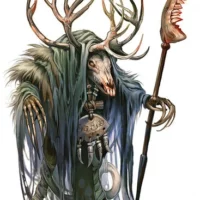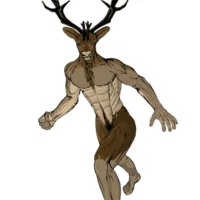Ijiraq : The Kidnapping Shapeshifter
Listen
At a glance
| Description | |
|---|---|
| Origin | Inuit Mythology |
| Classification | Spirits |
| Family Members | N/A |
| Region | Greenland, Canada, Alaska |
| Associated With | Kidnapping, Shapeshifting |
Ijiraq
Introduction
The unforgiving Arctic landscape of the Inuit people is not just a physical terrain, but a canvas woven with stories of spirits and creatures both benevolent and malevolent. Among these, the Ijiraq (pronounced ee-yi-rahk or ee-ji-rahk) stands out as a chilling figure, a shape-shifting kidnapper lurking in the shadows. This enigmatic being from Inuit mythology is notorious for its ability to transform its appearance and for abducting children, hiding them away before abandoning them. If the captured children can persuade the Ijiraq to release them, they can use inuksuk of stone to navigate their way back home.
The Ijiraq’s stories, rich with folklore and legend, offer a glimpse into the cultural and spiritual life of the Inuit people. Passed down through generations, these tales serve as both cautionary lessons and cultural teachings, highlighting the Ijiraq’s elusive and mysterious nature. The Ijiraq remains a captivating figure in Inuit mythology, embodying the themes of transformation, danger, and the intricate relationship between humans and the Arctic environment.
Physical Traits
The Ijiraq, a notorious shapeshifter in Inuit mythology, possesses the extraordinary ability to assume any form it desires, from wolves and bears to reindeer, ravens, and even humans. Despite these varied appearances, the Ijiraq’s glowing red eyes remain a constant, piercing identifier. In its human guise, the creature’s unsettling features set it apart: eyes and lips oriented sideways, blinking, and closing vertically, which adds to its eerie presence. In its natural state, the Ijiraq is often described as a shadowy, elusive figure that blends seamlessly into the Arctic landscape, making it nearly invisible and extraordinarily difficult to capture.
When adopting an animal form, the Ijiraq typically chooses creatures native to the Arctic, such as caribou, foxes, or owls, allowing it to move swiftly and silently across the tundra. This shape-shifting ability highlights its role as a trickster and master of deception. Descriptions of the Ijiraq’s true form vary; some stories depict it as a humanoid figure with distorted features, while others suggest its form is indistinguishable, reflecting its elusiveness and capacity to blend into the environment. This variability emphasizes the Ijiraq’s enigmatic nature, making it a prominent symbol of transformation and mystery in Inuit mythology.
Family
The Ijiraq, a singular entity in Inuit mythology, lacks a known family or lineage, existing as a solitary creature within the Arctic rainforests. Its origins remain veiled in enigma, with various tales proposing different narratives. Some suggest the Ijiraq as spirits inhabiting a realm between the physical and the spiritual, perpetuating their isolation and potential malevolence. Another belief speculates that they were once human, with stories from the South Baffin region recounting the plight of Inuit hunters lost between the worlds of the living and the dead, their souls metamorphosing into the formidable Ijiraq.
While Inuit mythology doesn’t extensively detail the Ijiraq’s familial connections, it’s often portrayed as a lone figure, symbolizing independence and otherworldly existence. This solitude underscores its status as an outlier, residing at the margins of both human and animal realms, never fully integrated into either. Nonetheless, some narratives hint at the Ijiraq’s possible affiliations with other mythological beings, such as the Tuurngait, spirits capable of influencing or possessing humans. These connections, often ambiguous and fragile, echo the Ijiraq’s mystique, with certain tales depicting it collaborating with these spirits, utilizing its shape-shifting prowess to advance their inscrutable agendas.
Other names
In the intricate web of Inuit mythology, the name “Ijiraq” carries profound meaning, translating to “Shape Shifter” in the North Baffin dialects, while it is also recognized as the “Ijiraat.” This enigmatic creature traverses various linguistic landscapes, known by an array of names across different Inuit communities. The term “Ijiraaluit,” used when discussing it in plural form, signifies the widespread nature of its legend, with each community infusing its own nuances into the creature’s story. These diverse appellations offer multifaceted insights into the Ijiraq’s character, with some names emphasizing its knack for disappearing or leading travelers astray, such as “the hidden one” or “the lost one.”
Moreover, the Ijiraq’s identity evolves across regions, manifesting in distinct names that highlight different facets of its nature. In East Baffin Island, it is known as “Qalupalik,” underscoring its role as a notorious child-stealer, while in Alaska, it is referred to as “Tununiq,” emphasizing its connection to the physical realm as a “land dweller.” These varying titles not only demonstrate the diversity within Inuit mythology but also accentuate the regional interpretations and cultural significance attributed to the elusive Ijiraq.
Powers and Abilities
The Ijiraq’s mastery of shapeshifting is its foremost power, allowing it to seamlessly transform between human and animal forms, rendering it deceitful and elusive. This ability enables the Ijiraq to navigate diverse environments effortlessly, whether traversing icy tundras or infiltrating human settlements, serving as a potent tool for deception and confusion. Moreover, the creature possesses the unnerving capability to steal memories from those it terrorizes, leaving its victims disoriented and unable to recall crucial details of their encounters, enhancing its mystique and making it even more insidious.
In addition to its shapeshifting prowess, the Ijiraq is attributed with powers of invisibility or near-invisibility, enabling it to move undetected and evade capture effortlessly. Its ability to appear and disappear at will reinforces its reputation as a master of stealth, enhancing its enigmatic aura. Some accounts even ascribe supernatural strength and speed to the Ijiraq, alongside a capacity to manipulate minds, blurring the lines between reality and illusion, further solidifying its status as a formidable adversary. The Ijiraq’s deep knowledge of the Arctic landscape adds another layer to its abilities, allowing it to disorient travelers through illusions, leading them astray and emphasizing the importance of respecting the land and being vigilant in one’s surroundings, a fundamental lesson deeply ingrained in Inuit culture.
Modern Day Influence
The enduring influence of the Ijiraq legend extends beyond traditional folklore, permeating modern Inuit culture and beyond. Within contemporary Inuit art and literature, the Ijiraq often emerges as a potent symbol of the enigmatic and unexplored realms. Artists and writers draw inspiration from its elusive essence to delve into themes of identity, metamorphosis, and humanity’s intricate relationship with nature. This portrayal serves to bridge traditional narratives with contemporary interpretations, preserving the essence of the Ijiraq while adapting it to modern storytelling mediums.
Moreover, the Ijiraq’s presence has expanded into popular media, including films, literature, and video games, where its myth undergoes reinterpretation, blending classic elements with fresh narratives. Whether appearing as a character in a fantasy novel or as a formidable creature encountered in an Arctic-themed video game, these modern adaptations introduce the Ijiraq to a wider audience, ensuring the longevity of its legend while embracing the evolution of storytelling. Beyond entertainment, the Ijiraq remains entrenched in Inuit culture as a vital cautionary tale, imparting lessons of vigilance to future generations and serving as a reminder of the inherent dangers lurking within the vast Arctic landscape.
Related Images
Frequently Asked Questions
What is lorem Ipsum?
I am text block. Click edit button to change this text. Lorem ipsum dolor sit amet, consectetur adipiscing elit. Ut elit tellus, luctus nec ullamcorper mattis, pulvinar dapibus leo.
What is lorem Ipsum?
I am text block. Click edit button to change this text. Lorem ipsum dolor sit amet, consectetur adipiscing elit. Ut elit tellus, luctus nec ullamcorper mattis, pulvinar dapibus leo.
What is lorem Ipsum?
I am text block. Click edit button to change this text. Lorem ipsum dolor sit amet, consectetur adipiscing elit. Ut elit tellus, luctus nec ullamcorper mattis, pulvinar dapibus leo.
What is lorem Ipsum?
I am text block. Click edit button to change this text. Lorem ipsum dolor sit amet, consectetur adipiscing elit. Ut elit tellus, luctus nec ullamcorper mattis, pulvinar dapibus leo.
What is lorem Ipsum?
I am text block. Click edit button to change this text. Lorem ipsum dolor sit amet, consectetur adipiscing elit. Ut elit tellus, luctus nec ullamcorper mattis, pulvinar dapibus leo.









